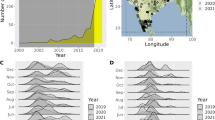Summary:
Comparative studies provide one of the most powerful means of assessing the relative roles of selective agents underlying social evolution in insects. Because of the wide variation in social organisation, sex allocation and ecological traits within and between species of allodapine bees, this group provides a wealth of material for such comparative work. Recent studies on Australian allodapine bees are reviewed here and their consequences for understanding social evolution are discussed. Studies to date suggest the following trends: (i) benefits of group living appear to be linked to preventing brood failure rather than to increased brood rearing efficiency; (ii) female-biased sex allocation, when it occurs, is linked to benefits of group living and kinship among nestmates, and is probably mediated via local fitness enhancement; (iii) female-biased sex allocation patterns do not usually coincide with opportunities for sib-rearing and are therefore unlikely to facilitate eusociality; (iv) relatedness within colonies is usually high, but in some species females will nest with unrelated females if kin are not available; and (v) phylogenetic studies suggest that opportunities for sib-rearing, arising from brood development patterns and colony phenology, are plesiomorphic for the exoneurine group, but in at least one phylogenetically distal clade, Exoneura sensu stricto, the evolution of large group size and social complexity coincides with the loss or reduction of opportunities for sib-rearing. Assured fitness return models may be applicable to weakly social allodapine species, but do not predict patterns of eusociality. Instead, Australian studies suggest that the evolution of large group size and marked reproductive skew is linked with the need to defend against enemies at the nest, rather than high levels of relatedness, female biased sex allocation or opportunities to rear siblings.
Similar content being viewed by others
Author information
Authors and Affiliations
Additional information
Received 8 May 1998; revised 10 July 1998; accepted 30 July 1998.
Rights and permissions
About this article
Cite this article
Schwarz, M., Bull, N. & Hogendoorn, K. Evolution of sociality in the allodapine bees: a review of sex allocation, ecology and evolution. Insectes soc. 45, 349–368 (1998). https://doi.org/10.1007/s000400050095
Issue Date:
DOI: https://doi.org/10.1007/s000400050095




